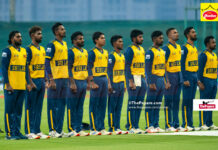We had a great Rugby final where the Kandy Sports Club showed us great discipline in Sports. Sadly though, Cricketers had to return back home, empty handed, having shown poor sports discipline in every skill and having lost almost every game. Today I’m going to write a lengthy searched article about DISCIPLINE.…to be precise – the much needed SPORTS DISCIPLINE. Once we organize and apply discipline in to the sports structure – well THEN you have the greatest platform to victory.
Therefore, take heed all you coaches & Sports Heads – take heed and read on….
When we look at sports discipline the paramount is understanding what SPORT is and what DISCIPLINE is, in isolation.
Sport is an activity involving physical exertion and skill in which an individual or team competes against another or others for entertainment. Discipline is the practice of training people to obey rules or a code of behaviour, using punishment to correct disobedience… etc
All coaches know that this is needed, most think they have it and only a very few understand what it really is and its mechanism. Discipline a key element in progressing and sustaining motivated hard-working sportsmen/women & teams and is commonly spoken about (very highly in certain instances) and widely recognized as a key aspect of coaching, but yet again, isn’t it the most common aspect neglected by coaches across the world? In fact the main objective of sport discipline is to enhance sport performance.
Sports discipline is also training to ensure proper behaviour, order, or calm organized conduct. However I have noticed that many label the acts of having athletes run until exhaustion, overtraining, and humiliating athletes with verbal degradation or in some cases using inappropriate language (filth), as discipline. Sadly this is not real sports discipline. Only activities that instill appropriate behaviour, willful adherence to authority or an environment of order should be considered effective discipline in the sport setting.
We must remember two main concepts to Sports Discipline or Coaching Discipline.
Conditioning method (Classical and Operant) and Locus of Control
Conditioning method – Classical conditioning – can be illustrated as the following: take a coach who prefers structured, serious practices. When an athlete acts disobediently during practice, the coach blows his whistle loudly and intensely, interrupts the drill, and demands the entire team to drop and do ten push-ups. As this occurs consistently throughout the season, the athletes begin to connect the abrupt shrill of the coach’s whistle to the act of dropping for ten push-ups. Eventually the coach no longer has to tell the team to do ten push-ups; rather, the whistle alone informs the athletes to do so. The whistle sound is the conditioned stimulus, the coach’s instruction to do ten push-ups is the unconditioned stimulus and the behaviour of doing push-ups becomes a conditioned response.
Operant conditioning – depending on the consequence, the athlete’s behaviour may change when faced with the same antecedents in subsequent situations. If we take the same situation as above the antecedents are the practice environment and drills, the behaviour is the athlete’s disobedient action and the consequence is performing ten push-ups. It can be assumed that the coach’s purpose for demanding the push-ups is to weaken the disobedient behaviour.
Behavioural conditioning can be tricky because there are a lot of factors to consider. Ideally, coaches should spend time developing their methods of behavioural conditioning, rather than blindly implementing consequences and/or using stimuli to establish conditioned responses.
The second psychology concept that applies to coaching discipline is Locus of control. Locus of control refers to a person’s perspective of who or what CONTROLS events in life. Locus of control can be internal, if the individual attributes events to his or her own behaviours, or external, if events are attributed to the actions of others. For example, consider a cross country runner who places second because he was passed in the last 50 meters of the race and hadn’t realized that another runner had been trailing him close enough for a competitive finish. If the athlete has an internal locus of control, he may think that he could and should have pushed and run harder all the way to the finish line instead of cruising with the assumption of a victory. However, if the athlete has an external locus of control, he may be quick to blame others for his loss, insisting that the coach or fans should have warned him that the runner was approaching.
Each sportsman’s locus of control greatly influences a team’s dynamic. Further, coaches may actually contribute to the cultivation of the sportsman’s locus of control, depending on the orientation of the team environment (task or ego-oriented) as well as the type of discipline the coach employs.
For me, sports discipline starts from a sportsman’s childhood. ANY discipline for that matter. However, the most important factor is to ENCOURAGE and DEVELOP self-discipline.
Children need to be able to recognize the need for dedication in any activity in which they hope to succeed and further their ability. Coaches should be aware of this responsibility and set a positive role model. This can be achieved in a number of ways.
Time keeping – Coaches should always arrive well in advance of any session in order to prepare and greet their students. Sessions should also finish on time in order that parents do not need to wait around for session to be completed.
Preparation – Coaches should demonstrate that they are prepared and that the session programme is organized and mutual goals have been set.
Communication – Coaches need to be able to communicate their programme to their students and provide opportunities for feedback from their students and their parents.
Discipline – Coaches need to be able to maintain an environment of respect for all within their sessions. THERE IS NO PLACE FOR AGGRESSIVE OR ABUSIVE LANGUAGE FROM A COACH.
The use of Penalties is an important element in the maintenance of discipline. The age and developmental stage of the child should be taken into consideration when using penalties. Penalties should be fair and consistent and in the case of persistent offence, should be progressively applied. They should never be used to retaliate or to make the person in charge feel better. The following steps are suggested and should always be used in conjunction with the code of conduct for young people:
Rules should be stated clearly and agreed upon
A warning should be given if a rule is broken
A penalty (for example, use of time out) should be applied if a rule is broken for a second time. The use of green, yellow and red cards are encouraged, irrespective of the sport
If a rule is broken for the third time the child should be spoken to, and if necessary, the parents/guardians may be involved
Penalty should not be applied if a coach is not comfortable with them. If an appropriate action cannot be devised right away, the child should be told that the matter will be dealt with later, at a specified time and as soon as possible
A child should not be punished for making errors when s/he is playing
Physical activity (e.g. Running laps or doing push-ups) should not be used as a penalty. To do so only causes a child to resent physical activity, something that s/he should learn to enjoy throughout his/her life
Penalties should be used sparingly. Constant punishment and criticism can cause a child to turn away from sport
Once penalties have been imposed, it is important to make the young person feel s/he is a valued member of the group again
Where relevant some punishments/penalties may need to be recorded and parents informed
Discipline in sport should always be positive in focus, providing the structure and rules that allow participants to learn to set their own goals and strive for them. It should encourage young people to become more responsible for themselves and therefore more independent.
Children should be helped to become responsible about the decisions and choices they make within sport, particularly when they are likely to make a difference between playing fairly and unfairly. There should be no place for fighting, over-aggressive or dangerous behaviour in sport.
The world of sport has become more and more stressful, competitive and the “win at all cost” attitude is still promoted by the media and some professional coaches. It is important to understand however that this attitude maybe “fair enough” amongst adults but it is completely inappropriate for children. Children are not “small adults” and in my opinion this “win at all costs” attitude is totally inappropriate as well as unnecessary for developing the skills and attitude required to achieve success.
Unfortunately there are still active coaches within this country and our sport who use intimidation, physical exercise as punishment, as well as constant criticism and sanctions designed to humiliate and thereby undermine the confidence and the self-esteem of your children. This is allowed solely because of short term “results” and the long term consequences are generally ignored. I have observed these long term consequences and conclude they have had a dramatic effect on the levels of participation within sport and a disproportionate number of talented players have retired from the game.
I believe that parents should take an active role in helping their child develop good sportsmanship and in order to do this and help your children get the most out of sport you need to be actively involved. This includes providing emotional support and positive feedback.
A number of steps can be taken in this regard including;
Attending some games and training sessions and talking about them afterwards.
Having a realistic expectation for your child and being aware of their personal goals.
Learning about the sport and supporting your child’s involvement
Helping your child talk to you about their experiences with their coach and other team members
Helping your child handle disappointment as well as successes appropriately
MODELLING RESPECTFUL SPECTATOR BEHAVIOUR
The behaviour of your child and their attitude reflects the combination of coaching and your discussions about the values of sportsmanship you yourself promote. It is also important to talk and observe when bad sportsmanship occurs at events and discuss other ways that this could be dealt with.
Always remember success is not the same thing as winning and failure is not the same thing as losing.
And finally, the lessons learned by children through sport will shape the values and behaviour of the child throughout their adult life and entire sporting career.
And for those of you who are bent on winning – Competition is the spice of sports; but if you make spice the whole meal you’ll be sick.
All the best!
Dr. Asanga Wijayaratne
















